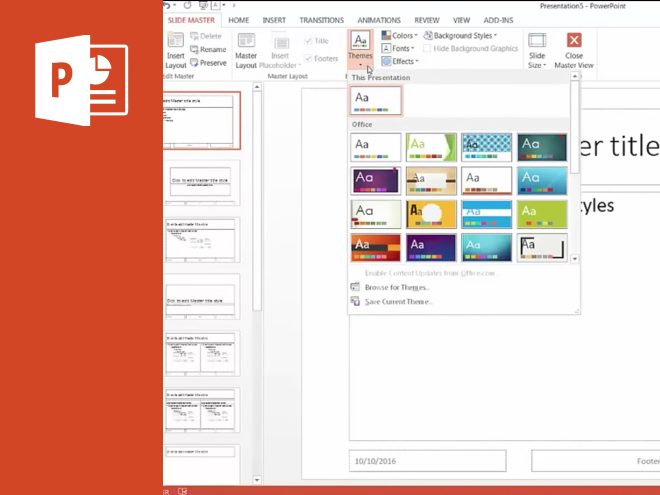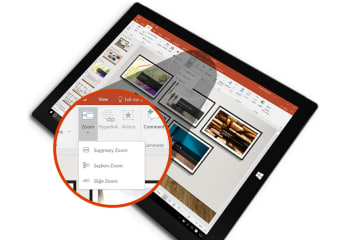


Each slide thumbnail is “live” so a presenter can click on it to jump directly to that part of the presentation instead of only being able to go forward or backward one slide at a time like normal.Ĭreating a Zoom slide is easy-users just go to “Insert – Zoom” and choose from 3 options: Summary Zoom, Section Zoom or Slide Zoom. Think of Zoom as a visual table of contents: It automatically generates a slide that looks like a menu of other slides in your presentation (you can choose which slides you want featured). While Morph helps link two slides together, Zoom can link entire sections of a presentation together-enabling presenters to show the overall context of a slideshow and easily navigate around the presentation in a non-linear way. Effects that required complicated animation sequences can now be achieved with Morph alone, saving time for everyone and enabling non-power users to create elegant visual sequences.
#Parts of microsoft powerpoint 2016 series#
When used effectively, Morph allows the presenter to create an impression of a continuous visual thread-like watching a video or a Prezi-instead of a series of independent slides. From a technical perspective, this effect is most easily achieved by designing the first slide, duplicating it and then adjusting those assets to create the second slide. Likewise, if I have a photo in the top left corner of the first slide and then I move it to the bottom right corner in the next slide, Morph will automatically recognize the change and shift the photo to its new location during the transition. Don’t see it? Make sure you have an updated Office 365 account with the latest version of PowerPoint 2016 ( check requirements).įor example, if I have a small circle on the first slide and I make that same circle larger in the following slide, Morph will recognize the circle as the same asset and it will automatically increase the size of the circle during the transition period between the two slides. The feature is also accessible at any time by clicking on the “Design” ribbon tab and choosing the “Design Ideas” category on the far right side of the menu. Just insert a photo or other visual content on a slide and a “Design Ideas” window will appear on the right side of the editor. The 8 suggestions Designer offers are especially valuable because they help presenters avoid the repetitive corporate template look and instead mix and match between modern, elegant design concepts with a variety of styles. With Designer though, a surprisingly high percentage of its suggestions were effective-on average about 5-6 of its 8 suggestions were usable without any tweaking, even when sampling different photos with varying dimensions. Over the years I’ve used “auto-generation” tools on many platforms and most of the time I found the suggested result required so much tweaking that it was easier to simply do it myself from the beginning. Simply put, Designer automatically generates a sample design concept for your slide as soon as you insert content (such as a photo) into it.

Ranking these new features on ease of use, Designer tops the list. These features have helped convince me this classic presentation platform can still serve forward-thinking presenters and I’m excited to share a few reasons why-continue on to see for yourself! Recently though, my feelings on using PowerPoint have shifted from a perspective of begrudgingly to one of interested and possibly even excited- specifically because of 3 new features Microsoft has debuted for its Office 365 subscribers: Designer, Morph and Zoom.ĭespite the names-which sound a bit like a long-lost disco group-the features deliver advanced capabilities to a platform that has seemingly remained stagnant for many years.ĭesigner allows presenters to quickly generate high-impact, professional-looking slides while Morph and Zoom improve continuation between slides-allowing the audience to better track the point of a presenter’s PowerPoint.

I’ve been critical of PowerPoint in the past because its linear structure made it difficult for presenters to communicate context and avoid losing the audience in a sea of endless slides.


 0 kommentar(er)
0 kommentar(er)
